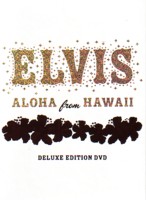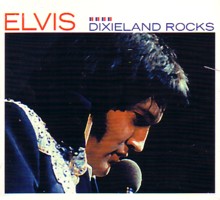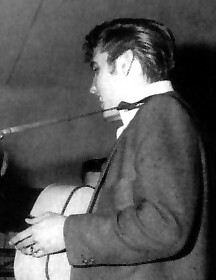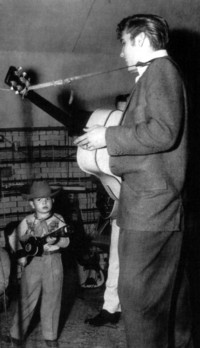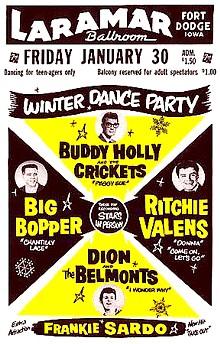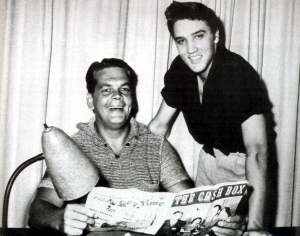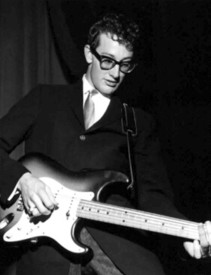 |
 |

Elvis, Buddy, Ely and the Cotton Club: Elvis was leaning a against his pink, 1954 Cadillac in front of Lubbock’s historic Cotton Club; the small crowd mesmerized by his great looks, cockiness and charisma. He put on quite a show, doing nearly all the talking. Elvis bragged about his sexual conquests, using language you didn’t hear around women. He said he’d been a truck driver six months earlier. Earlier, at the Fair Park Coliseum, Elvis had signed girl’s arms, foreheads, bras and panties. No one had ever seen anything like it. We had met Elvis’ first manager, Bob Neal, bass player Bill Black and guitarist Scotty Moore. They wanted us to bring some beer out to the Cotton Club. So we did. My meeting with Neal in 1955 was to have great meaning in my future. I was 15. Elvis did several shows in Lubbock during his first year on the road, in 1955. When he first came here, he made $75. His appearance in 1956 paid $4,000. When he arrived in Lubbock, Neal was with him. By the end of the year, Col. Tom Parker had taken over. Elvis played the Fair Park for its opening on Jan. 6, with a package show. When he played the Fair Park again, Feb. 13, it was memorable. Parker and Neal were there. Buddy Holly and Bob Montgomery were on the bill. Waylon Jennings was there. Elvis was 19. Buddy, 18.
Wade’s dad, Big Ed Wilkes, managed country comedian Jerry Clower on MCA Records. Pappy Dave Stone, the first owner of KDAV, helped Buddy get his record contract with Decca / MCA. Another jockey at KDAV was Arlie Duff. He wrote the country classic, "Y’all Come." It has been recorded by 19 well-known artists, including Bing Crosby. When Jennings and Don Bowman were hired by the Corbin brothers, Slim, Sky and Larry, of KLLL, Buddy started to hang around there. Niki Sullivan, one of the original Crickets, was a singing DJ at KLLL. Corbin has an excellent book about this radio era and the intense competition between KLLL and KDAV. All the DJs had mottos. Corbin’s was "lover, fighter, wild horse rider, and a purty fair windmill man." Bowman’s motto was "come a foggin’ cowboy." He’d make fun of the sponsors and get fired. We played poker together. He’d take breaks from game to sing funny songs. I played poker with Buddy before and after he got famous. He was incredibly polite and never had a big head. The nation only knew Buddy for less than two years. He was the most famous guy around Lubbock from the age of 14. Sullivan and I had a singing duo as children. We cut little acetates in 1948. We also appeared several times on Bob Nash’s kid talent show on KFYO. This was at the Midway Theater. Buddy and Charlene Hancock, Tommy’s wife, also appeared on this show. Larry Holley, Buddy’s brother (Buddy had dropped the "e" for his stage name), financed his early career, buying him a guitar and whatever else he needed. Buddy recorded 20 acetates at KDAV from 1953 until 1957. He also did a lot of recording at KLLL. Larry Holley said Niki was the most talented Cricket except Buddy. Buddy and Elvis met at the Cotton Club. Buddy taught Elvis the lyrics to the Drifter’s "Money Honey." After that, Buddy met Elvis on each of his Lubbock visits. I think Elvis went to the Cotton Club on every Lubbock appearance. When Elvis played a show at the Johnson Connelly Pontiac showroom, Mac Davis was there. I was too. The last time Elvis played the Fair Park on April 10,1956, he was as famous as it gets. Buddy, Sonny Curtis, Jerry Allison and Don Guess were a front act. They did two shows and played for 10,000 people. Those wonderful I.G. Holmes photos, taken at several locations, usually show Buddy and his pals with Elvis. Lubbock had a population of 80,000 at the time. Elvis was still signing everything put in front of him. Not many people could have signing women as a hobby. Many of the acetates recorded at KLLL and KDAV by Buddy and others were later released, many as bootlegs. When Buddy recorded four songs at KDAV, the demo got him his first record contract. It wasn’t just Lubbock radio that so supportive of Buddy Holly. The city of Lubbock hired him to play at teenage dances. He appeared at Lubbock High School assemblies and many other places in town. Everyone in Lubbock cheered Buddy on with his career. The newspaper reports were always positive. At one teenage gig, maybe at the Glassarama, there was only a small crowd. Some of us were doing the "dirty bop." The Lubbock Avalanche-Journal had photos the next day showing people with their eyes covered with a black strip. Sonny Curtis mentions that in his song, "The Real Buddy Holly Story." When Buddy and the Crickets were on the Ed Sullivan show, the newspaper featured that. The whole town watched. Buddy was fighting with his manager, Norman Petty, over money before he died. They were totally estranged. Larry Holley told me that Norman said to Buddy, "I’ll see you dead before you get a penny." A few weeks later, Buddy was dead.
In 1976, I was managing the Joe Ely Band. They had recorded an as-yet -to-be-released album for MCA Records. I was in Nashville to meet with the MCA execs. They wanted Joe to get a booking contract and mentioned some unheard of two-man shops. Bob Neal, Elvis’ first manager, had great success in talent managing and booking. He sold his agency to the William Morris Agency, the biggest booking agency in the world, and stayed on as president of the Nashville branch.
We could not believe our good fortune. The agency sent the Ely band coast to coast and to Europe, first to front Merle Haggard, then on a second trip to front England’s the Clash. The original band was Lloyd Maines, steel guitar, Jesse Taylor, electric guitar, Steve Keeton, drums, and Gregg Wright, bass. Ponty Bone, on accordion, joined a little later. The band did the shows and the recording. The recorded tunes were originals from Joe Ely, Butch Hancock, and Jimmie Dale Gilmore. However, some of the William Morris bookings led to zig-zag travel over long distances to so-called "listening clubs." When I complained to Neal, he’d recall the 300 dates Elvis played back in 1955. Four guys in Elvis’ pink Cadillac. When Buddy made some money, he bought a pink Cadillac. Joe Ely bought a pristine, 1957 pink Cadillac that was much nicer than either of the others’. When I’d hear from Neal, it was very good news, especially the fantastic, uniformly-rave, album and performance reviews from newspapers and magazines everywhere. Time Magazine devoted a full page to Joe. The earliest big rock critic to praise Ely was Joe Nick Patoski, author of the definitive and critically-acclaimed "Willie Nelson: An Epic Life." After one year, MCA was in turmoil. Big stars were leaving or filing lawsuits. We were told they might not re-new the option to make a second record. MCA regularly fired everyone we liked. Neal thought the band should go to Los Angeles for a one-nighter. He booked the Ely band into the best known club on the West Coast, the Palomino, owned by his dear pal, Tommy Thomas. We alerted other record companies. They drove back and forth to L.A. in a Dodge van to play only one night. Robert Hilburn, the top rock critic for the Los Angeles Times, came with his date Linda Ronstadt. The Ely band loved to play music. They started on time, took short breaks and played until someone made them stop. Hilburn wrote that Ely could be, "the most important male singer to emerge in country music since the mid-60s crop of Waylon Jennings, Merle Haggard and Willie Nelson." Hilburn praised each of the band individually. He was blown away when they just kept playing when the lights came on at closing time. After that, several major record companies were interested. The last time I saw Neal was at the Old Waldorf in San Francisco on Feb. 22, 1979. Little Pete, a black drarf who was always around Stubb’s Bar-B-Q, was traveling with the band. To open the show, Little Pete came out and announced, "Lubbock, Texas, produces the Joe Ely Band!" Then he jumped off the elevated stage and Bo Billingsley, the giant roady, caught him. Neal, the old showman that had seen it all, just loved that. Writer Johnny Hughes was raised in Lubbock and is the author of "Texas Poker Wisdom." added text & images by EIN -Copyright EIN, January 2009 Click here to comment on this article
|
|
